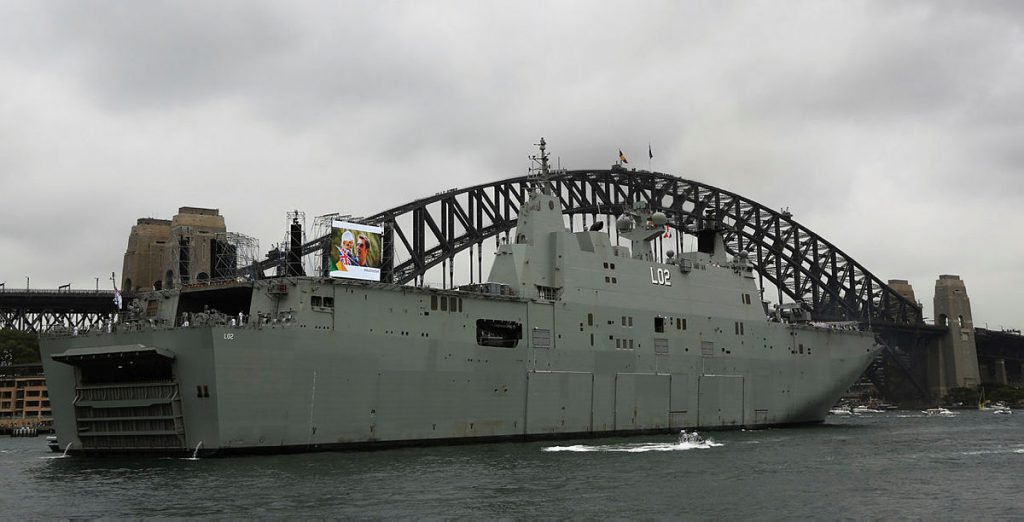
The Royal Australian Navy’s flagship, HMAS Canberra, has completed trials off the NSW coast to help engineers assess whether its mechanical problems have been caused by a serious design flaw or a less serious issue, such as degraded seals.
The Navy’s two giant Amphibious Assault Ships, also known as Landing Helicopter Docks or LHDs, at 27,000 tonnes, they are the biggest ships ever operated by the RAN. Both have had problems with the two large ‘azimuth pods’ which drive and steer the vessels.
Canberra’s sister ship, HMAS Adelaide, is in dry dock in Sydney’s Garden Island so that it’s pods can be dismantled, examined and undergo routine maintenance. The decision to move the Adelaide into dry dock was made in large part so that bearings in its pods could be thoroughly examined, said Navy chief Vice Admiral Barrett: ‘It’s inconclusive at the moment.’
Instead of having a drive shaft running through the ships from engines to propeller, and a conventional rudder, the LHDs have two electrically driven pods near the stern of the ship, each bearing two forward and aft sets of 4.5 metre propellers. They increase the vessels’ manoeuvrability by swivelling to push or pull them in the required direction. Similar pods are used on many modern cruise ships, allowing them to dock easily with little or no assistance from tugs.
The azimuth pod system makes room at the stern of the vessels for landing craft to enter and leave via a giant well dock which is flooded to launch and recover them. Each ship can carry 1000 troops with all their equipment and a formidable array of armoured vehicles.
The LHDs were built by the Spanish company, Navantia, and their propulsion systems came from Germany’s Siemens. The British firm BAE Systems was the project integrator and prime contractor. All three companies have sent specialists to work through the issues.
The Spanish Armada has one such ship of its own, the
Juan Carlos. It is currently due to have one of its pods repaired in Spain, but because of a different issue, apparently relating to a seal and bolts at the point where an azimuth pod meets its hull.
Australian Navy chief Admiral Tim Barrett and the head of maritime systems at Defence's capability and sustainment group, Rear Admiral Adam Grunsell, said different problems had emerged with the pods on HMAS Canberra and HMAS Adelaide. Oils of different viscosity used in separate parts of each pod were found to have mixed in one of Canberra’s pods, possibly because a seal had failed.
In a pod from HMAS Adelaide, particles believed to be metal fragments were found mixed with oil. The physical examination is intended to find out if the metal came from a bearing wearing excessively, or from another metal part. Until the bearings were thoroughly examined it would not be clear how serious the damage was, Vice Admiral Barrett said, though he said that the amount of particulate matter found in one of HMAS Adelaide’s pods ‘was not catastrophic’.
The Australian ships have already travelled about twice the distance of the Spanish Navy’s vessel. Vice Admiral Barrett said the RAN had operated its two ships within their specifications. ‘We are investigating whether there are differences in how we operate.’ He has been in close contact with the Armada over the issue.
The pods contain sensors to monitor issues such as oil temperature, vibration and bilge level. Some of them were found to be malfunctioning and they’ll be replaced. HMAS Canberra can still operate at cruising speed of around 16 knots.
The two ships were to be stars of the show at the coming Talisman Sabre exercise with the United States and other allies in June, but Vice Admiral Barrett said the Adelaide wasn’t likely to be available in time He hopes the Canberra would take part, but said that other Navy vessels could fill the gap.
With HMAS Adelaide in dry dock the engineers will be able to check if seals have become unseated. They’ll also assess whether the particles found in the oil had been worn off a metal part such as a bearing or a shaft because of a relatively minor problem with a seal, or because of a more serious issue elsewhere in the system. ‘The program is to discount things, to point to whether it’s a bearing issue for instance, and from there we’ll decide whether to change its activity, an operating limit or something along those lines,’ Vice Admiral Barrett said.
Rear Admiral Grunsell said the three companies involved were working very closely with the Navy to find out what was wrong. ‘They want to understand what caused this as well. It may well be something simple or a design issue. ‘
Vice Admiral Barrett said the ships may still have some residual warranty but commercial sensitivities had to be managed. Last October, the ships had a problem with their high voltage cabling systems which was resolved with the help of the manufacturer.
Vice Admiral Barrett said the possibilities were being narrowed down. The answer might be as simple as a seal being pinched when the pod was assembled. ‘We’re slowly working through what it’s not to determine what it is’, he said.
Rear Admiral Adam Grunsell added: ‘It’s a complex array of equipment down there and the purpose of the investigation is to look at every piece of equipment in a disciplined engineering fashion so that we can rule in or rule out contributing factors. It may be a singular cause, or it may be an aggregation of a number of issues’.
 Print This Post
Print This Post